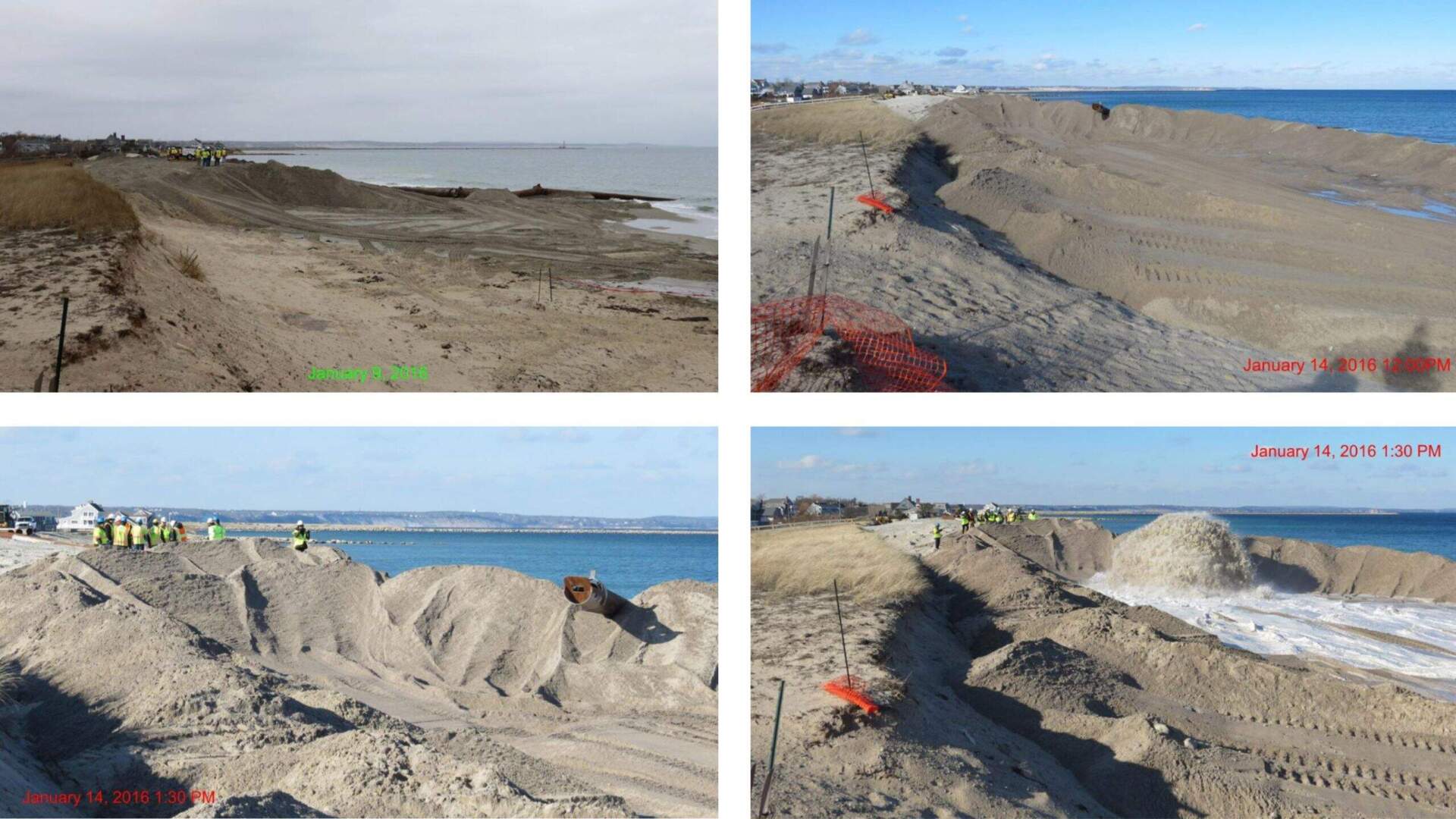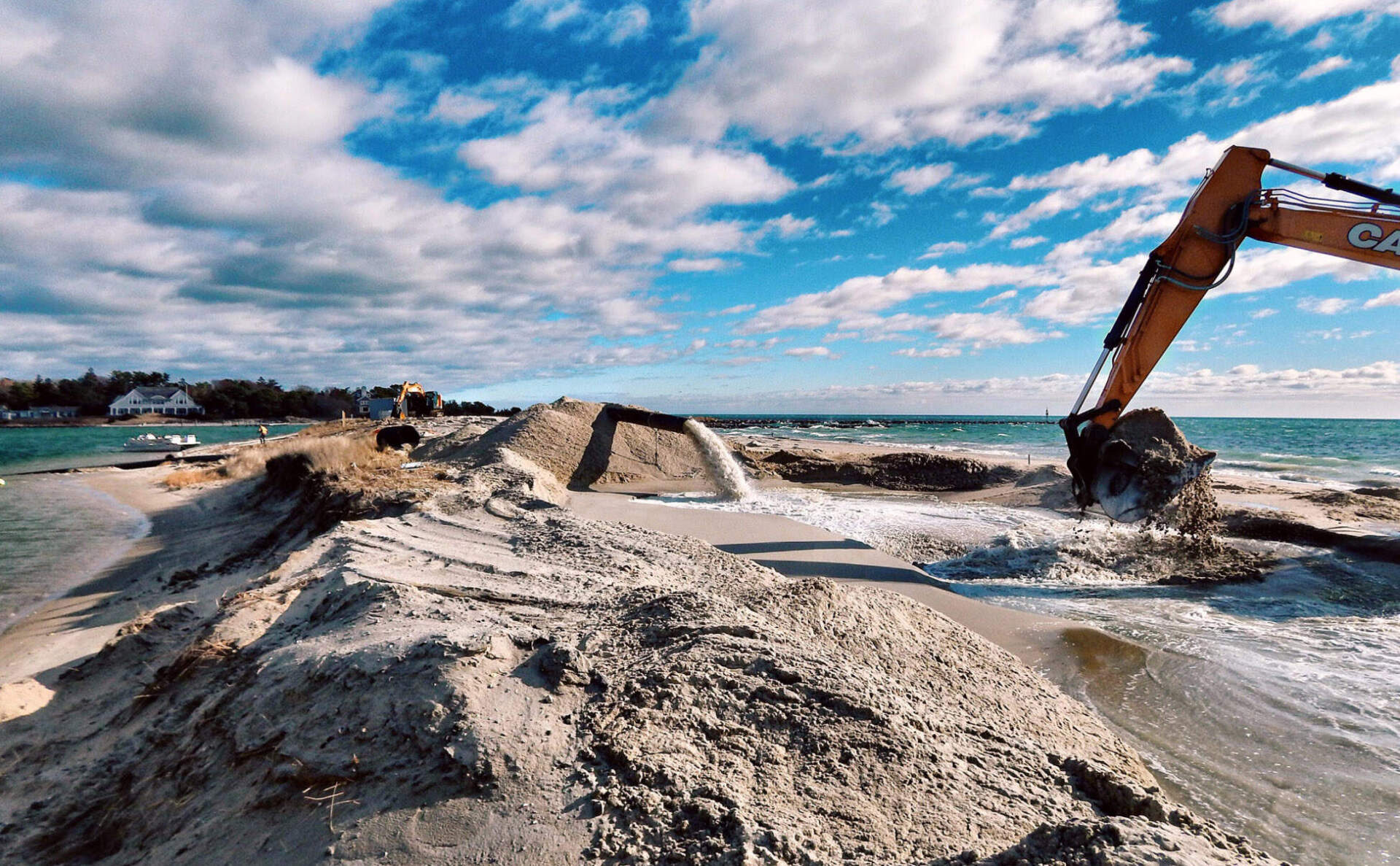Advertisement
Against the tide, communities battle beach erosion

Dave DeConto remembers learning to swim in the frigid waters of Cape Cod Bay as a child in the 1960s. He remembers how the tall and vast sand dunes sloped down into the water at Town Neck beach in Sandwich. A lot has changed since then.
Blizzards and nor'easters have wiped out homes, eroded sand, and even clogged a creek. DeConto, the town's director of natural resources, said these extreme weather events have taken “bite after bite after bite” out of the coastline. Two century-old jetties built to keep sand from accumulating in the Cape Cod Canal also contributed to erosion.
In October, following a smaller effort to restore the beach in 2016, the U.S. Army Corps of Engineers returned to Town Neck to deposit about 30,000 dump trucks full of sand. This strategy, known as “beach nourishment,” is aimed at shoring up what remains of the beach.
In many coastal communities, rising seas and extreme weather linked to climate change are heightening the effects of erosion. These forces threaten homes, businesses and wildlife habitats, and they’re leading residents to wonder whether interventions such as beach nourishment can provide some respite from the relentless tides.

In Sandwich, the jetties that have adversely affected Town Neck beach serve a purpose further north: preventing the current from washing debris and sediment into the Cape Cod Canal, an intercoastal waterway that moves much of the region's commerce. Likewise, on Sampsons Island near Barnstable, jetties designed to keep the channel open have contributed to erosion and shorebird habitat loss.
Elsewhere in Massachusetts, state officials have invested millions of taxpayer dollars in communities struggling with dune erosion. The town of Salisbury, on the New Hampshire border, has received almost $4 million in state and federal money over the last 70 years for beach nourishment, according to data compiled by researchers at West Carolina University. A partnership on Cape Cod that includes the town of Barnstable, Mass Audubon and the Barnstable Clean Water Coalition spent a decade and $2.8 million on revitalization efforts for Sampsons Island. In October, the Healey administration announced it would award $5.2 million to 16 communities across the commonwealth for coastal resilience projects.
Advertisement
An imperfect solution
In some cases, these projects have helped restore thriving and healthy dune systems and shield coastal areas from raging storms and a rising sea. But experts say beach renourishment projects are impermanent solutions that require continual upkeep. Satellite imagery from before and after the restoration efforts shows a dramatic change, but it's one that noticeably diminishes over time. The project in Sandwich, for example, will require maintenance every five to seven years unless the jetties are removed.
“Most nourishment projects in our area, particularly down the Cape, don't last,” said Chad McGuire, a professor of public policy at the University of Massachusetts, Dartmouth whose work focuses on the intersection of environmental science and environmental law. “They're just band-aids at best, for something that has an underlying cause that we're not talking about.”
With erosion worsening due to climate change, McGuire said one of the only long-term solutions is for towns to begin moving properties away from the coast. Soon, he said, residents will have “no choice but to effectively move away from risky areas.” But on Salisbury beach, residents like Ray Champagne say they aren’t going anywhere.
“We're adamant that we want to save Salisbury Beach. We like where we live,” said Champagne, who has lived in Salisbury for 44 years. “We should be allowed to do what we have to do to save our properties.”
Champagne said he and other residents want to use government funding to help pay for newer technology to address incessant dune erosion. One of those techniques, known as trap bags, acts as an alternative to seawalls. But residents say restrictive state and federal laws prevent them from trying this and other innovative solutions.
Residents say they’re hamstrung by 1968 Massachusetts guidelines that require structures within a 100-year floodplain to be built in accordance with federal and state building codes. As a result, “we are not even allowed to put up a solid fence” on the beach, Champagne said. Residents have instead resorted to more traditional methods, continually adding sand to reinforce dunes up and down the coastline.
“I live 100 yards away from New Hampshire, they don't have the same rules,” said Champagne. “They protect, they build, they install things. In Massachusetts, we're not allowed to do any of that.”
Some alternatives, like jetties and seawalls, can control the pace of erosion on one beach, but at a cost to sand dunes on another beach. Still, Colonel Justin Pabis, commander of the New England District of the Army Corp of Engineers, said the region should explore every option.
“Constructing new jetties in New England is fairly restricted by local laws. Constructing breakwaters is restricted by local laws. Putting in groins into the water is also restricted,” Pabis said. “But if those were the appropriate solution to protect the citizens and the town, the crucial habitat, then those are things we should look into.”
Economies and wildlife hang in the balance
At Sandwich’s department of natural resources, DeConto estimates the town has undertaken six small renourishment projects over the past 15 years, planting sea grasses and rebuilding snow fences each time. He said the town's continued effort to restore its sand dunes has faced some resistance.
“A lot of people will say, 'Well, you know, I don't understand why we're spending all this money on sand just to protect wealthy people's homes on the beach,' and that couldn't be further from the truth,” he said.
If the sand barrier at Town Neck Beach erodes, downtown Sandwich could risk flooding during storms. Sandwich Marsh could become “Sandwich harbor,” DeConto warned. A Climate Change Vulnerability Assessment analysis showed that nourished sand dunes could prevent as much as $5.9 million in flood damage to the town's infrastructure in the case of a 100-year storm event.
In Salisbury, continually-renourished dunes safeguard the Great Marsh as well as Route 1A, a major north-south highway running the length of the state.
“The Great Marsh is a very important component of the environment. It’s a carbon absorber,” said Salisbury resident Don Egan, interim president of the Salisbury Beach Betterment Association. “It stretches all the way from here in Salisbury down to almost Gloucester, so it's important to protect that.”
Barrier beaches and communities surrounding wetlands like the Great Marsh are “the habitat[s] for birds and all kinds of wildlife,” Champagne said. “We're talking about protecting that as well as the impact to the community.”
As beaches erode, the habitats of birds like piping plovers, least terns, and common terns all but disappear. This is especially concerning for piping plovers, which are considered threatened in Massachusetts and endangered in the Great Lakes region.
“One common misconception is that terns and plovers nest up in the dunes,” said Lyra Brennan, director of the Coastal Waterbird Program at Mass Audubon, who worked on the Sampsons Island project. “They're down in that beautiful area where you might want to put your beach chair, in the sandy section of the beach … and they have no other place for them to go.”

According to Brennan, the piping plover count at Sampsons Island went from eight pairs to 27 after a dredging project there, which removed the western tip of the island and redistributed the sand across the eastern portion. Similar positive effects were seen in Town Neck, where a maintenance dredging project was conducted last year.
Champagne and other coastal residents across Massachusetts say they’re committed to protecting their communities from erosion by almost any means necessary — they just wish the process were easier and government regulations would allow them more flexibility. Some experts are more skeptical.
“It's about making things resilient,” explained McGuire, the University of Massachusetts, Dartmouth professor. “But what does it mean to make it resilient? Is it resilient for a day? Is it resilient for a season, for a year, for a decade?”
Editor's note: The Open Source Investigations Lab at Northeastern University’s School of Journalism combines traditional reporting with analysis of digital evidence found in satellite imagery, videos and social media. The reporting team for this project was Omotoyosi Ajisafe, Jessie Catellano, Emily Chung, Sonel Cutler, Ian Dartley, Harriet Gaye, Jiarui Liu, Rebeca Pereira, Colette Pollauf, Matt Rushford, Jordan Sun and Hikari Terasawa, working with journalism professor Dan Zedek.